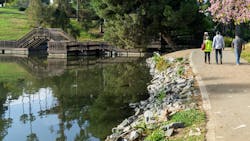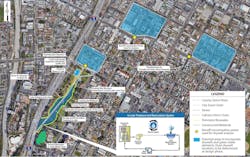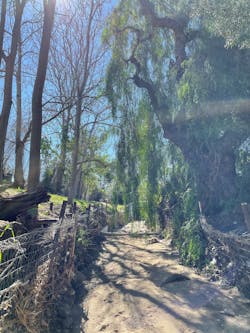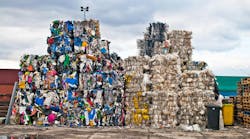Los Angeles’ stormwater capture project investment to improve stormwater quality & water supply
Sept. 19, 2023
8 min read
Throughout Los Angeles' (LA) history, imported water has been a necessity, making up a significant portion of the city’s water sources. LA’s current infrastructure is unable to fully utilize the city’s occasional storm events for beneficial use or for much needed groundwater replenishment. With the city’s Green New Deal aiming to source 70% of its water supply locally by 2035, city leadership has placed an emphasis on multi-benefit stormwater capture projects. These projects will aim to improve water quality, replenish LA’s groundwater basins, and increase recreational benefits especially for those neighborhoods who already have repeatedly faced many economic, health and environmental hardships historically.
Addressing Stormwater Challenges
Over the past several years, the City of Los Angeles’ Bureau of Sanitation and Environment (LASAN) has developed innovative projects that address LA’s growing stormwater quality challenges and dwindling drinking water supply, while also supporting and investing in communities that especially need it most.
These projects have varying goals for water and environmental management. Aside from replenishing LA’s groundwater basins and improving water quality in the LA River and watersheds, projects aim to alleviate localized flooding and provide recreational and environmental benefits to the community. The projects are also anticipated to bolster the city’s local water supply, reducing dependence on imported water and supporting LA’s Green New Deal; which also aims to double the average
annual quantity of stormwater captured from approximately 24 billion gallons per year to more than 49 billion gallons per year by 2035.
These efforts are prudent and provide support for LA’s Green New Deal goals and One Water LA plan. However, these efforts require significant financial support and funding to complete, which in and of itself can be a challenge to secure. Over the course of four funding rounds, LASAN has secured $186.9M for infrastructure projects, operation and maintenance, and scientific studies from the prestigious LA Regional Safe Clean Water (SCW) Program’s Regional Infrastructure Program. Examples described in this article have secured a total of $30.2 million of funding in Round 4, which includes $25.2 million for the Hollenbeck Park Lake Rehabilitation Project and $5 mllion for the Sylmar Channel Project.
The Regional Infrastructure Program requires all proposed efforts to describe how they intend to plan, build and maintain multi-benefit watershed-based projects to improve water quality, increase supply and enhance communities. More specifically, the program ultimately scores projects according to the following criteria to determine eligibility for SCW funding:
Water quality benefits: This criterion is scored through an evaluation of water quality needs; municipal separate storm sewer systems (MS4) permit compliance; 24-hour storm capacity, event-based design details; and long-term performance. The MS4 Permit uses the Enhanced Watershed Management Program (EWMP) Plans in LA County (County) to determine the network of best management practices (BMPs) that will achieve required pollutant reductions at the state and federal level, while also providing enhanced community benefits and leveraging sustainable green infra- structure practices. Elements of the EWMP Plans include water quality priorities, watershed control measures, reasonable assurance analysis, scheduling, monitoring, assessment, and adaptive management.
Water supply benefits: This criterion is scored through an evaluation of water supply needs within a watershed area;
the nexus between water supply and stormwater or urban runoff captured, infiltrated, or diverted by a project; benefit magnitude such as water diverted to a separate groundwater recharge facility, to a water treatment plant, or to a sanitary sewer for conversion into recycled water; and the cost-effectiveness of the generated benefits.
Community investment benefits: This criterion is scored through an evaluation of community investment and local support needs of a watershed area and the actual investment and support of local, community-based organizations gained through a project’s outreach and engagement.
Nature-based solutions: This criterion is scored through an evaluation of project elements that leverage nature-based solutions such as use of natural processes, use of natural materials, and removal of impermeable areas.
Leveraged funds and community support: This criterion is scored through an evaluation of percentage funding matched and a demonstration of strong local, com- munity-based support.Multi-benefit projects
LASAN’s Hollenbeck Park Lake Rehabilitation Project (Hollenbeck) and Sylmar Channel Project (Sylmar) are both multi-benefit stormwater projects that use nature-based solutions to meet LA’s goals of improving water quality within the watersheds, increasing water supply via groundwater recharge, and benefiting the communities in which these projects reside. Hollenbeck Park, a 21-acre park with a 4.3-acre lake at its center within LA’s Boyle Heights neighborhood, receives several influent stormwater flows to the park’s lake from residential LA City and LA County storm drains, as well from a storm drain from the nearby freeway. Sylmar Channel, an approximately 0.5-mile-long channel located in LA’s San Fernando Valley, transports flow via open channel through the residential neighborhood to an LA County storm drain. Hollenbeck and Sylmar have been developed to comply with the MS4 Permit’s EWMP Plans, meeting BMP performance goals and compliance targets for metals and bacteria, while also promoting water conservation, flood risk management, aesthetics improvement, recreational opportunities, and public education in each watershed.
The pollutant reductions for Hollenbeck and Sylmar were simulated using LA County’s Water Management Modeling System 2 (WMMS2), which comprises two primary continuous simulation models: Loading Simulation Program in C++ (LSPC) and System for Urban Stormwater Treatment and Analysis Integration (SUSTAIN). LSPC simulates rainfall and unoff and pollutant build-up and wash- off. These simulated flows and pollutant loads are then routed through SUSTAIN to simulate BMP performance. LSPC is parametrized by spatially defining arrays of land uses, soil parameters and slopes. WMMS2 utilized 96 combinations of land characteristics to simulate inflow to the projects. Spatially variable pollutant loads can be attributed to land use variability within the drainage area. The land use parameters have been calibrated for the LA region and have undergone peer review and regulatory input.
Design details were input into SUSTAIN to simulate BMP performance. The 85th percentile, 24-hour storms were simulated in SUSTAIN using LA County’s four-day banding time series. Load reduction conditions were simulated over a 10-year period to estimate the average annual performance. The annual water supply benefit or infiltration volume was modeled using long-term continuous simulation with SUSTAIN. The infiltration volume was modeled using rainfall data over a 20-year period.
Design of each project’s infiltration volume is optimized to capture as much of the 85th percentile, 24-hour storm or to achieve 80% pollutant reduction, whichever proves to be most cost efficient. Although the goal is to capture all of the project’s design storm runoff, a cost-effective approach can allow a project to significantly decrease localized flooding and still meet – and even exceed – necessary compliance goals.
Hollenbeck plans to implement diversions from influent storm drains, diverting flows to a subsurface storage unit that allows
for storage and infiltration, as well as pumping flows to the lake. Lake enhancements consist of in-lake treatment, constructed wet- lands, and perimeter bioswales. Along with the implementation of nearby drywells and green street elements, the project is expected to capture 347.7 acre-feet of runoff annually, removing pollutants through treatment, including 81% reduction of the primary pollutant zinc and 100% reduction of trash from captured runoff. Through these stormwater diversions, capture, and treatment BMPs, along with park and lake enhancements, the project will improve water quality and increase water supply within the much needed Upper LA River watershed.
Sylmar’s scope includes improvements to the channel for inline bioretention and additional green street network components, such as drywells and bioswales. The project demonstrates significant benefits in improved water quality, with a more than 80% reduction of its primary pollutant zinc and 100% reduction in trash from captured runoff. Additionally, this project expects an annual capture of 206 acre-feet of water for aquifer recharge, enhancing LA’s water supply. By implementing various improve- ments and BMPs, flood mitigation and environmental restoration are also promoted, ensuring improved public safety and increased recreational opportunities for the neighborhood.
In conclusion
By leveraging the funding opportunities provided by LA County’s SCW Program, LASAN can address many critical water needs across the city. Through this regional infrastructure program, LASAN has proven to improve water quality and reduce reliance on external sources of water supply, while simultaneously providing localized flood risk mitigation, environmental restoration, expanded recreational opportunities, and other impactful benefits in these communities that greatly need it — fulfilling the city’s sustainability and equity goals, as well as LA’s Green New Deal and One Water LA plans. LASAN will continue to implement these projects for at least the next five years, contributing to SCW Program’s current estimated 56,915 acre-feet per year of average annual stormwater capture. These projects developed by LASAN and partially funded through the county’s SCW Program are the cornerstone of municipal collaborations that can address the nation’s need for multi-benefit stormwater projects during the ever-rising climate change crisis.
About the Author
Sunshine Saucedo
Sunshine Saucedo is a staff engineer at Carollo Engineers, Inc. Saucedo can be reached at [email protected].
Sign up for our eNewsletters
Get the latest news and updates




